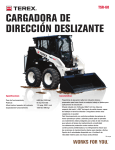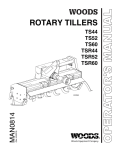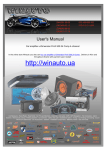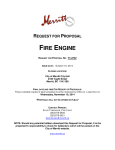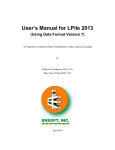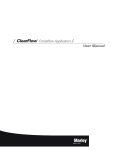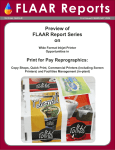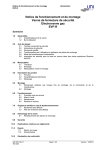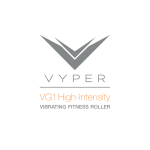Download SUPERPILE INSTALLATION MANUAL
Transcript
SUPERPILE INSTALLATION MANUAL Marine Contractors Guide for SUPERPILE Installations www.assetint.co.uk Asset International reserves the right to edit and modify literature, please consult the web site for the most current version of this document. SUPERPILE OVERVIEW SUPERPILE is a highly engineered composite pile designed and manufactured exclusively for fender, mooring and compression pile applications. SUPERPILE is manufactured by the pultrusion process. A continuous process in which resin and reinforcements are saturated and guided into a heated die where the curing process commences. Pultrusion Process Schematic SUPERPILE is manufactured with a two component polyol/isocyanate polyurethane matrix, with a fiberglass reinforcement architecture comprised of 11Msi Modulus/290 ksi tensile strength fiberglass, manufactured to ASTM D578 specifications. The outer layer is comprised of a 10 mil thick, synthetic UV protection veil. SUPERPILE is environmentally friendly featuring a low carbon footprint. SUPERPILE will not leach chemicals or harm the environment. SUPERPILE TU460 (16”) Production SHIPPING AND RECEIVING SUPERPILE is shipped to the job site via flatbed dedicated truck. The continuous manufacturing process permits Creative Pultrusions, Inc. (CPI) to manufacture piles to long lengths eliminating the need for splices. Prior to shipping, the contractor shall communicate with CPI regarding the packaging and shipping method. Considerations shall include but may not be limited to: • • • • Dedicated Truck Hauling 80’ piles to Margate, New Jersey Û1 Length of piles Quantity of piles on the truck Weight of the pile packages Unloading method PROPER HANDLING UPON DELIVERY Proper care should be taken during handling. The piles were packaged and loaded on the flatbed with a tow motor. Contact CPI for the weights of the piles and individual packages. Proper care should be taken when removing the tie-down straps. Although the piles are cradled in wood chalks, never assume that the wood chalks will keep the piles from shifting. will reduce the chance of the pile sliding during the picking process. CPI prefers to use Light pole handling slings, made by Lift-It® (http://www.lift-it.com). The slings must be double wrapped and the manufacturer’s recommendations must be followed. The pultruded piles are smooth and can be very slippery if they become wet. Never use steel chokers or chains to unload the piles. A nylon strap, preferably with a neoprene skin is recommended. This Lift-It® Sling Double Wrapped Around SUPERPILE VISUAL INSPECTION UPON DELIVERY Upon delivery of the piles, the piles shall be inspected for damage that could affect the long term performance of the piles. Normal wear and tear including abrasions and scuff marks are common and shall not cause concern. The piles shall be free from delaminations. The separation can be penetrated by a needle. If the defect is over 3/8” wide, it is a delamination and not a process shrinkage crack. The piles shall be free from dry fiber, a condition in which fibers are not fully encapsulated by resin during the pultrusion process. The piles shall be free from fracture caused by improper handling during shipping. Example of Fracture Damage Caused by Tow Motor Fork Impact Example of Delamination in a FRP Square Tube A delamination is a separation of two or more layers or plies of reinforcing material within a pultrusion. Example of Dry Fiber in a Pultruded Panel 2Ü DIMENSIONAL INSPECTION UPON DELIVERY Bow: Piles shall be straight to within .020”/ft. of length measured by weight minimizing the bow. (Note: Weight minimizing refers to the pile laying flat on the ground in contact with the flat ground and the bow measured at peak height.). Length: Piles shall meet the specified length to +/- 2”. Wall thickness: Shall be ±15% of the nominal wall thickness. DRILLING AND CUTTING INSTRUCTION SUPERPILE can be drilled with carbide tipped drill bits. CPI recommends B & A Manufacturing Company (http://www.bamanufacturing.com) FGH series drill bits, for applications that require multiple holes in a short period of time. Many contractors and utilities have had success when utilizing the FGH series drill bits. The bits will save time and drill thousands of holes before needing to be replaced. FGH Series Fiberglass Pile Drillng Bit SUPERPILE can be field cut with a concrete, skill or reciprocating saw. An abrasive blade should always be used. Concrete saws work the best and can be utilized with a standard concrete cutting blade. During drill and sawing operations dust will be emitted. The dust is considered a nuisance dust, which can irritate your eyes and skin. Therefore, safety glasses, gloves and long sleeve shirts are recommended during the cutting and drilling process. As documented by OSHA, FRP dust millings have potential to cause eye, skin, and upper respiratory tract irritation. • Cause - mechanical-irritant properties of the glass fibers. • FRP particulate is Non-Hazardous. • FRP particulate is greater than 6 microns therefore, it cannot reach the alveoli. • The International Agency for Research on Cancer (IARC) classified FRP particulate as non-cancer causing in June of 1987. Û3 Concrete Saw CONNECTION DETAILS SUPERPILE connections should be made with galvanized or stainless steel connectors as designed and approved by the Engineer of Record (EOR). Holes should be drilled based on the nominal bolt diameter oversized by 1/16”. Pin Bearing Strength – Pin bearing strengths are detailed in the technical data sheet for the various SUPERPILE sections. Note that the pin bearing strength varies based on the direction of the load. The Length Wise (LW) bearing strength is normally higher than the Cross Wise (CW) pin bearing strength and must be considered during the design process. In the event that signage, conduits, or other non-structural appendages are required to be mounted to the FRP piles, stainless steel self drilling screws should be utilized to make the connection as lag screws; nails and staples cannot be utilized. Torque Limits – Proper care must be taken not to over torque the through bolts during construction. The SUPERPILE, like any hollow section, is susceptible to damage due to over tightening and “egg shaping” or crushing the pile. Therefore, a maximum torque of 30 lb-ft. is recommended. If a torque wrench is not available or utilized during construction, tighten the nut until the compression spring washer has been collapsed and then, turn the nut another ½ turn. This method has been utilized by the utility industry, successfully for over 10 years. Oversized Washers – Connections should always be made with oversized washers that match the radius of the pile. FRP piles are extremely strong. However, the Modulus of Elasticity is about 1/5th that of steel. Therefore, highly concentrated loads are required to be dissipated over a larger area of the pile section. CPI recommends that washers measuring 6”x 6” x 3/8” manufactured in galvanized or stainless steel, be utilized for all bolted connections into the pile. (Note: All testing was performed with 50 ksi 4” x 4” x 3/8” and 6” x 6”x 3/8” steel washers.). Point Loads – SUPERPILE was designed for an ultimate crush strength of 27 kips, spread over a nine inch length of the pile. In the event, the pile connection or impact loads will be greater than the ultimate strength, with the appropriate safety factors applied, the crush strength can be increased by increasing the wall thickness of the pile. Always consider the crush strength capacity when designing the pile to dock connections. The reaction loads may require a thicker pile with a saddle connection. Oversized Curved Washer Crush Strength Test 4Ü INSTALLATION OPTIONS Vibratory Hammer SUPERPILE can be efficiently driven with a vibratory hammer. When utilizing a vibratory hammer an adaptor shall be fabricated to connect the pile to the vibratory hammer. The adaptor shall include an interior steel pipe that fits into the SUPERPILE, to guide the pile. The interior tube should be between 0.5” and 2” of the interior diameter of the FRP pile. The interior pipe shall be welded onto a flat steel plate. The steel plate will apply the compression force into the top of the pile. The steel plate shall be connected to a beam that can be clamped by the vibratory hammer. The contractor is cautioned that on some occasions the pile may require an FRP insert for added compression or pin bearing strength. Therefore, the interior diameter of the pile will change. The contrac- tor should base the vibratory adaptor fabrication on the approved pile drawings. In the event that a pile needs to be pulled, a vibratory hammer can be Example of Vibratory Hammer Steel Fabrication utilized to pull the piles. Through bolt the pile and the drive head with three 1” diameter bolts spaced a minimum of 5” apart. Vibrate the pile and pull tension until the pile begins to move. Once the friction has broken, pull the pile without the vibratory hammer engaged. The vibratory hammer oscillation will cause the bolt holes to elongate if engaged for an extended period of time. Typical Vibratory Drive Hammer Specifications (courtesy of RPI Construction Equipment) IMPORTANT NOTICE: In reference to the proper use of this equipment, please be advised that job site conditions may vary due to a change in the geology of a particular area. It is always a good practice to consult with a geotechnical engineer prior to starting a project. Also, a good rule of thumb is to know your soil conditions before selecting pile driving equipment. This can be accomplished by reviewing test soil borings before every project. The above equipment is being used in a granular soil condition which is recommended when using vibratory driver / extractors. ~ RPI Construction Equipment Û5 INSTALLATION OPTIONS Air and Diesel Hammers Diesel and Air Hammers have been utilized to drive the 12” and 16” SUPERPILES. A pipe insert driving head or steel pipe cap is required for driving the hollow FRP piles. It is important that the piles are impacted so that the driving force is dissipated over the cross section of the top of the pile. Vulcan 01 Impact Hammer Driving 16” Diameter SUPERPILE Example of Pipe Insert Driving Head for Driving Hollow Piles PILE DYNAMIC ANALYSIS CPI contracted to Crofton Construction Services Inc. and to Atlantic Coast Engineering in order to have a Pile Dynamic Analysis (PDA) performed on SUPERPILE. Crofton Construction Services Inc. installed two SUPERPILES, one with a Vulcan 01 Impact Hammer and one with an APE D30-32 Impact Hammer. Both piles were driven with a steel toe plate bolted to the bottom of the pile in order to increase the driving resistance of the soils. The pile driven with the Vulcan 01 Air Hammer was driven to refusal (120 blows/ft.) at a depth of 35 feet and then extracted for visual inspection. The pile driven with the APE D30-32 hammer was driven to a depth of 50 feet, allowed to set overnight, and was re-driven on the following date with dynamic test gauges attached to the pile. Testing was performed to aid contractors in the selection of the appropriate impact hammers for installation of the SUPERPILES. And, to establish, for Geotechnical Engineers, the feasible soil resistances in which the piles may be driven without damage and to identify the allowable driving stress. The rated capacity of each hammer is utilized in the PDA as follows: 6Ü PILE DYNAMIC ANALYSIS (Cont’d) The test pile driven with the Vulcan 01 Impact Hammer, to refusal, demonstrated a driving resistance of 160 kips, a driving energy of 8 kip-ft., and a compressive driving stress of 8 ksi. The pile was extracted, inspected and revealed no signs of damage. The test pile driven with the larger APE D30-32 Impact Hammer was driven through the same soils at a blowcount of 9 blows/ft. ending at a blowcount of 12 blows/ft., which was evaluated to represent a resistance of 200 kips with a compressive stress of 11 ksi. No evidence of damage was observed. After a one day set up period, the pile was driven with the APE D30-32 Impact Hammer at a substantially greater resistance. At 235 blows/ft. a driving resistance of 340-370 kips, an average energy transfer of 30 ksi and a recorded compressive driving stress of 13-15 ksi, the pile head split and the pile failed. The PDA testing indicates that impact hammers with a rated energy of 15 to 35 kip-ft are appropriate for the installation of SUPERPILES. Hammers with rated energies in the range of 35 to 50 kip-ft should be used with some level of caution. COMPRESSION LOADS SUPERPILES exhibit very high compressive strengths and load carrying capabilities. The following chart depicts the ultimate compression loads that the piles can sustain during the driving process without buckling. The loads are considered ultimate loads and should be factored accordingly. Column Length Ultimate Compresssion Load (lbs.) 16"x1/2" 12"x1/2" Feet SUPERPILE SUPERPILE 5.0 1,265,081 1,698,424 10.0 1,586,362 1,226,963 15.0 705,050 602,793 20.0 396,590 339,071 25.0 217,005 253,818 30.0 176,262 150,698 35.0 129,499 110,717 40.0 99,148 84,768 66,977 45.0 78,339 50.0 63,454 54,251 55.0 52,442 44,836 60.0 44,066 37,675 65.0 37,547 32,101 70.0 32,375 27,679 75.0 28,202 24,112 80.0 24,787 21,192 85.0 21,957 18,772 90.0 19,585 16,744 95.0 17,577 15,028 100.0 15,864 13,563 K = 1 Pinned-Pinned End conditions assumed 12"x3/8" SUPERPILE 957,829 824,797 366,576 206,199 131,967 91,644 67,330 51,550 40,731 32,992 27,266 22,911 19,522 16,833 14,663 12,887 11,416 10,183 9,139 8,248 FOR MORE DETAILS ON SUPERPILE CONTACT: Richard McTavish Tel: +44(0)1633 637513 / Fax: +44(0)1633290519 / Email: [email protected] Stephenson Street, Newport, NP19 4XH, UK Tel: +44(0)1633637513 / Fax: +44(0)1633290519 www.assetint.co.uk








